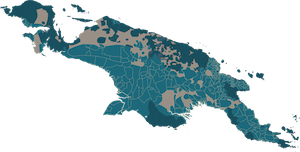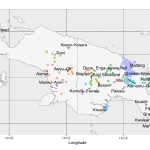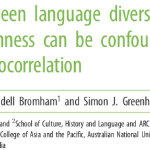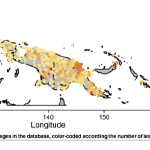Project: TransNewGuinea.org: Trans-New Guinea Online

TransNewGuinea.org is a database of the Trans-New Guinea language family and friends. The Trans-New Guinea language family currently occupies most of the interior of New Guinea. This family is possibly the third largest in the world with 400 languages and is tentatively thought to have originated with root-crop agriculture around 10,000 years ago. However, vanishingly little is known about this family’s history.
Publications from this Project:
Tentatively tracing Trans‐New Guinea: A phylogenetic evaluation of potential deeper relationships..

Greenhill SJ. In Press. Tentatively tracing Trans‐New Guinea: A phylogenetic evaluation of potential deeper relationships.. In Evans N & Fedden S (Eds). The Oxford Guide to the Papuan Languages. Oxford University Press: Oxford.
The Trans‐New Guinea language family is one of the world’s largest language families. Strikingly it is also one of the world’s least studied. There is ongoing debate about which of many languages should be included in Trans‐New Guinea and how these relate to each other. Resolving this debate is hard due to the complexities of studying New Guinea languages, and a lack of adequate data suitable for detailed historical linguistic work. These difficulties have led to suggestions that the only way forward is to wait for low‐level descriptive 15 field‐work and detailed bottom‐up historical …
Abstract PDF 10.31235/osf.io/628cvLinks between language diversity and species richness can be confounded by spatial autocorrelation.

Cardillo M, Bromham L, Greenhill SJ. 2015. Links between language diversity and species richness can be confounded by spatial autocorrelation. Proceedings of the Royal Society of London B, 282: 20142986.
Turvey & Pettorelli [1] present a fascinating study exploring links between biological and linguistic diversity across New Guinea. With the world’s highest linguistic diversity (around 900 languages, an average of one language per 1000 km2 [2]), as well as the high biodiversity characteristic of a large mountainous tropical island, New Guinea is an ideal test case for investigating patterns and drivers of biocultural diversity. Turvey & Pettorelli's finding that numbers of languages and mammal species are correlated across grid cells in New Guinea is consistent with studies in other parts of …
Abstract PDF 10.1098/rspb.2014.2986TransNewGuinea.org: An Online Database of New Guinea Languages.

Greenhill SJ. 2015. TransNewGuinea.org: An Online Database of New Guinea Languages. PLoS ONE 10(10): e0141563.
The island of New Guinea has the world’s highest linguistic diversity, with more than 900 languages divided into at least 23 distinct language families. This diversity includes the world’s third largest language family: Trans-New Guinea. However, the region is one of the world’s least well studied, and primary data is scattered across a wide range of publications and more often then not hidden in unpublished “gray” literature. The lack of primary research data on the New Guinea languages has been a major impediment to our under-standing of these languages, and the history of the peoples in New …
Abstract PDF 10.1371/journal.pone.0141563 Website Overview